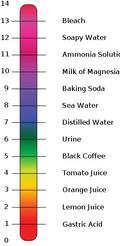 | ||||
Acids, Bases, Buffers & pH
Practice Test Questions
Virtual Cell Biology Classroom of Science Prof Online
Acids, Bases, Buffers & pH Sample Test Qus
Free review questions to help students better understand
 | ||||||
SPO VIRTUAL CLASSROOMS
The following questions, from the Virtual Cell Biology Classroom, are designed to help students better understand Inorganic Chemistry. All questions are based on materials that can be found on the Acids, Bases Buffers & pH Lecture Main Page.
a. has fewer hydrogen ions
b. has more hydrogen ions
c has an equal number of hydrogen ions
d. is less concentrated
3. A salt is:
a. A compound that dissociates in water and releases hydrogen ions (H+).
b. An atom that dissociates in water and forms cations and anions.
c. A compound that dissociates in water and releases hydroxyl ions (OH-).
d. A compound that dissociates in water and produces cations or anions other then H+ or OH-.
4. Each number on the pH scale represents a ________ change in H+ concentration.
a. one point
b. tenfold
c. hundredfold
d. ten thousandfold
e. negative
1. When bacterial cultures are grown in the lab, products of bacterial metabolism can build up making the environment too acidic or alkaline
for the bacteria to thrive. What is the best thing to add to the growing medium to keep the bacteria healthy?
a. everclear
b. a base
c. buffer
d. protein
2. A solution that is at a pH of 8 ______ than a solution with a pH of 1.
Page last updated:
5/2016
5. The body's bicarbonate buffer system functions to keep the pH of the blood neutral. Which two organs/systems are primarily involved in keeping this buffer system balanced?
a. lungs, liver
b. digestive, circulatory
c. digestive, respiratory
d. kidneys, lungs
e. immune, circulatory
6. The difference between a strong acid and a weak acid involves...
a. how much of it dissociates in water
b. how much it synthesizes in water
c. how much of it changes into water
d. hours spent lifting weights
7. Most of the fluids produced by the human body are ...
a. very acidic
b. in the neutral range
c. very basic
d. very alkaline
 | ||||||
SPO offers free PowerPoint lectures, sample test
questions, review questions and assignments on many different science topics.
Below are links to those that relate to chemistry:
You have FREE access to a large collection of materials used in a college-level introductory biology course. The Virtual Biology Classroom provides a wide range of free educational resources including PowerPoint Lectures, Study Guides, Review Questions & Practice Test Questions.




